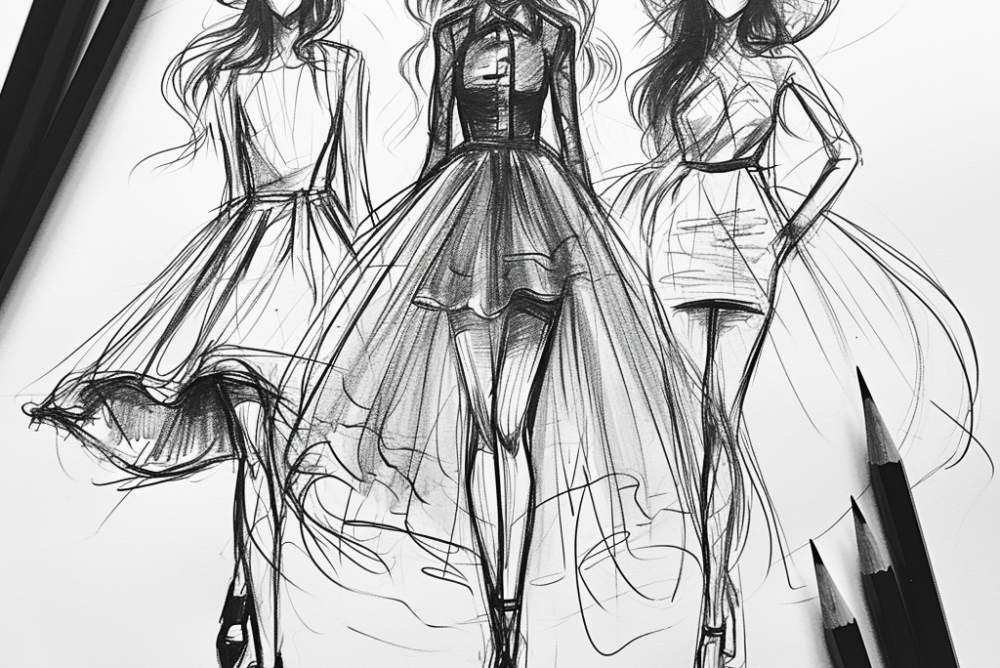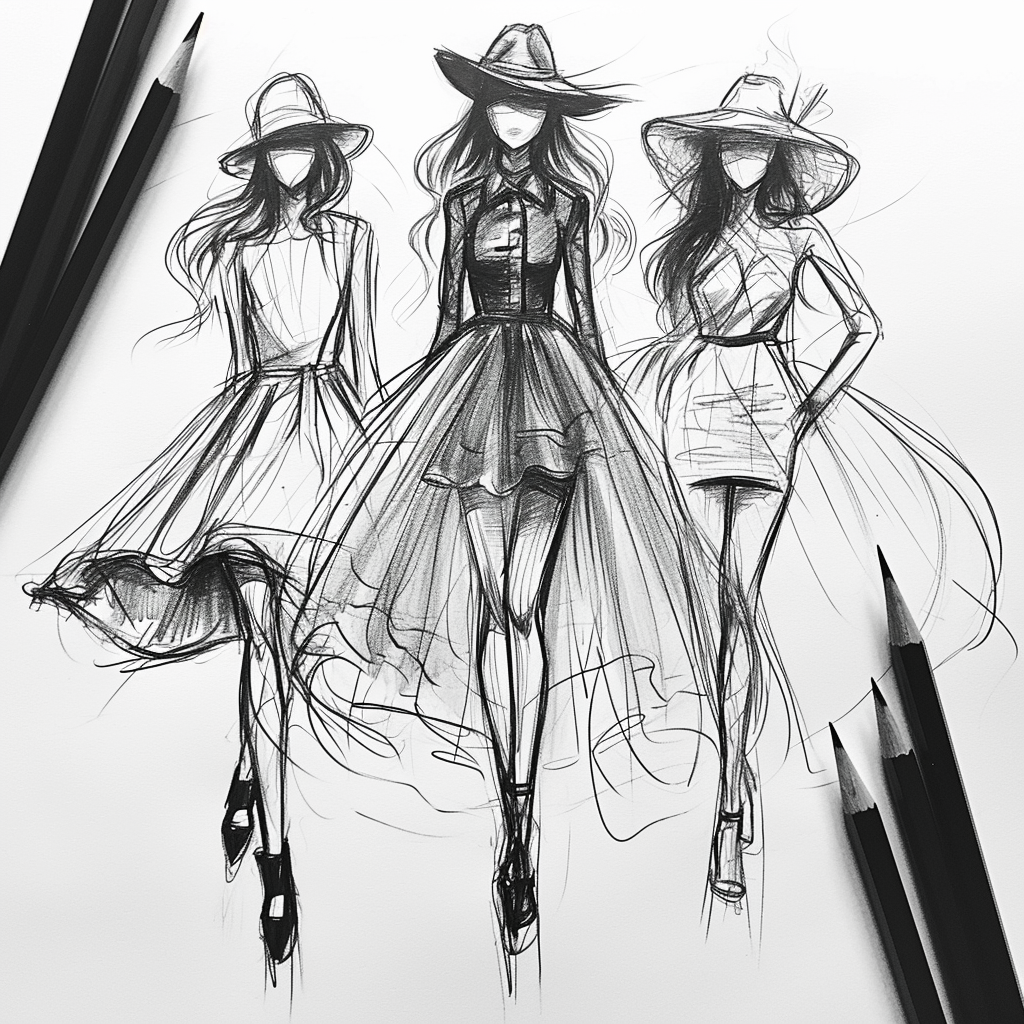Beginner's Guide to Sketching Chic Fashion Designs with Style


Fashion design sketches are the first step in bringing a designer's creative vision to life. These sketches allow fashion designers to communicate their ideas on paper before creating the actual garments. For aspiring designers looking to hone their skills, learning how to draw basic fashion sketches is essential. With some practice and the right materials, anyone can start sketching fashion figures and designing clothing.
This comprehensive guide aims to provide beginners with the knowledge and techniques to start sketching fashion designs. We will cover the supplies you need to get started as well as methods for sketching proportional figures and basic garments. You will learn how to sketch both female and male fashion figures in different poses. Finally, we will discuss how you can develop your own unique style.
Follow along as we break down step-by-step how to translate your fashion design ideas onto paper. With the fundamentals in this guide, you will gain the confidence to bring your sketches to life. The first step is gathering the right supplies and setting up your workspace.
Gathering Materials and Supplies for Fashion Sketching
Before starting your first fashion sketch, you will need to gather some basic materials and supplies. Having the right tools and setting up an organized workspace will help your sketches come to life. Here are the recommended supplies to have on hand:
Drawing paper - For beginning sketching, a drawing pad or stack of drawing sheets like a newsprint pad is ideal. Look for paper that is lightweight and has a bit of tooth or texture. Smooth paper may cause pencils to skip.
Pencils - HB and 2B pencils are good options for sketching outlines and basic shading. You may also want a separate eraser like a kneaded eraser to lift graphite.
Blending stumps or tortillons - These are cylindrical paper tools used to smooth shading and blend pencil strokes. They can create nice gradations.
Rulers and French curves - Used for sketching straight lines and seam lines. French curves help when sketching curved areas like sleeves.
Colored pencils or markers - For adding color to your fashion sketches after initial drafting.
Art gum eraser - Can be shaped to erase fine details and lines.
Sketchbook - For storing your drawings together over time. Look for acid-free paper.
Your workspace should have good lighting and a smooth, sturdy surface for drawing. Tape down your paper rather than sketching directly in a sketchbook. This will allow you to focus on your strokes. Also have a sharpener and cups for holding tools. Setting up an organized, inspiring workspace will make fashion sketching feel effortless.
Learning Basic Shapes and Proportions
Before drawing complete fashion figures, it helps to practice sketching basic shapes and forms. Getting proportions and angles right is key to making your sketches look accurate. Take time to draw cylinders, cubes, spheres, cones and other geometric shapes. This will train your hand and brain to visualize shapes in 3D.
Once you feel comfortable with simple shapes, move on to sketching the building blocks of the human form:
Head - The head is an oval shape and is generally 1/8 the full height of the fashion figure.
Shoulders - Shoulder width is about 2 to 3 head lengths across. Shoulders are boxes to start.
Torso - The torso makes up half the full height in an average figure. It consists of rectangular and triangular shapes.
Arms - Arms come down to about hip length and connect at the shoulders. Hands are almond shaped.
Legs - Legs are generally 5 to 7 heads in height. They are a series of tubes and cylinders.
Feet - Feet are wedge shapes and are about 1/6 the full height.
Practice sketching these main body masses until you can draw them quickly. Getting the angles and alignments right will ensure your figures have natural, balanced proportions.
Move on to drawing the basic shapes of garments next. Sketch elongated rectangles for dresses or triangles and diamonds for blouses. Straight lines help compose sleeves and pants. Sketch fabrics draping over the figure with concave curves. Learning fundamental shapes will make garments look proportional.
With these core building blocks, you will have the foundation to start sketching well-composed fashion designs. Take it step by step and focus on precision. In the next chapter, we will cover sketching complete female figures.
Sketching the Female Fashion Figure
Now that you have practiced sketching shapes and proportions, it’s time to draw a complete female fashion figure. Here are some tips for getting the proportions and poses right:
Start with a line sketch representing the head, torso, and legs. Lightly sketch the oval head, rectangular torso, and connecting vertical lines representing the neck and legs.
Add the arms with shoulders, coming down to hip points at each side. Shoulders should measure 2-3 head lengths across.
Divide the height into 8 equal sections. The crotch point lands around section 5.
Sketch inverted triangles for the hands. They should come to mid-thigh.
Draw wedge shapes for the feet which end about section 1.
Refine the angles of the joints, contours of the hips and waist. Erase guide lines.
Consider the pose. Fashion figures commonly have more attitude than standard figure drawing. Experiment with shifting the hips or shoulders to create movement.
Once you have a proportional figure sketch, it's time to add garments. Dresses can start with triangle shapes. Draw over the form to create folds and drapes that follow the body. Add key details like collars, buttons and hemlines last.
Practice sketching different fashion poses like turned profile, back views, sitting or hands on hips. Varying the pose can bring your sketch to life. Observe photos of fashion models to see how clothing drapes naturally with poses.
Take your time when sketching the female form and adding garments. Check proportions and let figures overlap to show depth. Keep practicing clean, precise strokes to make figures come to life.
Sketching the Male Fashion Figure
The basics of sketching a proportional male figure are similar to a female form. However, there are some subtle differences to capture a masculine frame. Here are tips for sketching a well-proportioned male fashion figure:
Start with the same oval head and vertical guide lines to map out the body shape.
Shoulders will be a bit wider than female at 3-4 head lengths across. Make shoulders more square shaped.
The torso and waist are less defined with straight lines versus curves.
Arms should have more angular contours than female arms.
Hands are slightly bigger with square palms and fingers.
Legs are longer, 6-7 heads in height. Make the calves more angular.
Feet are a bit longer and wider.
Pose the figure with more straight, rigid stances rather than soft curves.
Use straight and angular lines when sketching male garments. Jackets have strong shoulder lines and straight proportions.
Pants should have clean creases and straight legs. Avoid too many curved lines.
Use shading on contours to show masculine muscle definition.
Practice varying male poses from standing straight, to hands in pockets, sitting, or walking.
Observe proportional photos of male models to maintain realistic sketches. Focus on the precise angles of male fashion figures.
With some adjustments from the female form, you can sketch proportional and realistic male figures. Practice clean lines and strong contours. Next, we’ll explore ways to develop your own sketching style.

Developing Your Own Style
Once you have practiced and are comfortable sketching proportional fashion figures, it’s time to develop your own unique style. The possibilities are endless when determining how to make your sketches stand out.
Consider the drawing technique you want to focus on. Some options include:
- Loose, gestural lines - Flowing contours and organic shapes
- Precise, clean lines - Crisp edges and attention to detail
- Crosshatching - Layers of parallel or overlapping lines for shading
- Blending - Smooth gradations and seamless shading
- Geometric shapes - Incorporating circles, squares and triangles
Also think about which media you prefer to use. For example:
- Colored pencils - For bold pops of color or subtle hues
- Markers - For graphic lines or airbrush techniques
- Watercolor - For fluidity and blending pigments
- Mixed media - Combining drawing materials for new effects
Don’t be afraid to exaggerate proportions or shapes for impact. Elongating limbs or enlarging heads can make exciting stylistic choices.
Take inspiration from art movements or your favorite designers. Channeling cubism, art deco or recreating McQueen’s silhouettes can influence your style.
Make sure to practice consistently and analyze other sketch artists’ techniques. Over time you will organically develop skills and approaches that feel most natural.
Let your creativity shine through in every sketch. Find freedom in making “mistakes” as you explore new directions. With some dedication, you will have sketches that show off your one-of-a-kind artistic vision.
Conclusion
Learning the fundamentals of fashion sketching opens up an exciting new creative outlet. With the right supplies and some dedicated practice, anyone can start drawing professional-looking fashion figures. This guide has equipped you with techniques for sketching proportional bodies, garments, and varied poses. Both male and female figures were covered to provide well-rounded guidance. Finally, you now have tips on developing your own artistic style.
Follow the steps in this guide to hone your fashion design skills one pencil stroke at a time. Draw inspiration from the fashion world around you. With consistent work, you will be amazed at the realistic figures and dazzling garments you can sketch. Becoming proficient at fashion sketching allows you to bring your visions to life on paper.
The knowledge gained here is just the beginning. Continue challenging yourself to improve proportions, silhouettes and detail work. Try new drawing materials and find ones that best suit your style. Sketch pieces inspired by historical fashion or forecast future trends. Above all, embrace your creativity and let it shine through in every pencil line. Sketching fashion designs takes practice but delivers immense reward. Turn your passion into beautiful art and see where your sketches can take you. The only limit is your imagination.





-500x500.jpg)
-500x500.jpg)
-500x500.jpg)
-500x500.jpg)
-500x500.jpg)